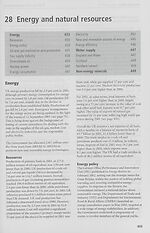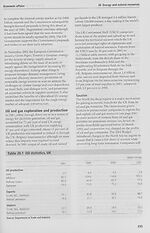Download files
Complete book:
Individual page:
Thumbnail gallery: Grid view | List view

Economic affairs
28 Energy and natural resources
The following assumptions formed the
background to the consultation:
■ liberalised and competitive markets will
continue to be a cornerstone of future energy
policy;
■ it is vital to maintain security of supply;
■ greenhouse gas emissions will need to be
reduced significantly during the 21st century
- this will need technological innovation,
with the potential for the UK to benefit from
moving to clean and low-carbon technologies
and improving performance in energy
efficiency;
■ competitiveness and affordability are also key
objectives of energy policy; and
■ climate change issues and some aspects of
security of supply are international questions:
the UK cannot therefore only act through
domestic policies but must also address these
issues through international policies and
agreements, particularly through EU market
liberalisation and the Kyoto Protocol
(see page 283).
The Government proposes to publish a White
Paper early in 2003 setting out its approach to
future energy policy in the light of the PIU report
and the findings from the consultation.
Climate change levy
In April 2001 the Government introduced the
climate change levy, a tax on business use of
energy, designed to encourage energy efficiency
across business, and thus help to bring about
lower emissions of greenhouse gases. It is a key
component in the Government’s Climate Change
Programme, and is contributing towards climate
change commitments, including the UK’s target
under the Kyoto Protocol to reduce greenhouse
gas emissions by 12.5 per cent below 1990 levels
by 2008-12 (see page 283).
The levy is designed to balance environmental
gains and the protection of business
competitiveness. It is expected to cut carbon
emissions by about 5 million tonnes a year by
2010. All revenues, however, are being recycled,
mainly through an offsetting cut in employer
National Insurance contributions, but also
through support for energy efficiency
programmes and renewables (see page 445).
To protect the international competitiveness of
energy-intensive industries, the Government
has provided an 80 per cent discount from the
levy for those sectors that agree targets for
improving their energy efficiency or reducing
carbon emissions.
International developments
Since 1999 the European Union’s (EU) Fifth
Framework Programme of Research and
Technological Development has been the focus of
research, development and demonstration of
energy technologies in the EU. The EU Energy
Framework Programme (EFP) 1998-2002 had six
separate components:
■ ETAP (shared studies and analyses);
■ SYNERGY (international co-operation on
security of supply and Kyoto targets);
■ ALTENER (renewable energy);
■ SAVE (strategic action for vigorous energy
efficiency);
■ SURE (safe transport of nuclear materials
and safeguards); and
■ CARNOT (clean and efficient use of solid
fuels).
The EFP is to be replaced by the Intelligent Energy
for Europe Programme (2003-06) comprising
SAVE, ALTENER, STEER (energy aspects of
transport) and COOPENER (international
co-operation in renewables and energy efficiency).
The European Commission collaborates with
specialist international organisations, notably the
International Energy Agency (IEA) in Paris, which
monitors world energy markets on behalf of
industrialised countries and promotes reform of
energy markets, both among its members and
internationally. The lEA’s membership consists of
all members of the Organisation for Economic
Co-operation and Development except Iceland
and Mexico.
The degree to which electricity and gas markets
have been opened to competition varies
considerably across the EU, with only the UK and
a few others allowing all consumers to choose
their suppliers. However, agreement was reached
434
28 Energy and natural resources
The following assumptions formed the
background to the consultation:
■ liberalised and competitive markets will
continue to be a cornerstone of future energy
policy;
■ it is vital to maintain security of supply;
■ greenhouse gas emissions will need to be
reduced significantly during the 21st century
- this will need technological innovation,
with the potential for the UK to benefit from
moving to clean and low-carbon technologies
and improving performance in energy
efficiency;
■ competitiveness and affordability are also key
objectives of energy policy; and
■ climate change issues and some aspects of
security of supply are international questions:
the UK cannot therefore only act through
domestic policies but must also address these
issues through international policies and
agreements, particularly through EU market
liberalisation and the Kyoto Protocol
(see page 283).
The Government proposes to publish a White
Paper early in 2003 setting out its approach to
future energy policy in the light of the PIU report
and the findings from the consultation.
Climate change levy
In April 2001 the Government introduced the
climate change levy, a tax on business use of
energy, designed to encourage energy efficiency
across business, and thus help to bring about
lower emissions of greenhouse gases. It is a key
component in the Government’s Climate Change
Programme, and is contributing towards climate
change commitments, including the UK’s target
under the Kyoto Protocol to reduce greenhouse
gas emissions by 12.5 per cent below 1990 levels
by 2008-12 (see page 283).
The levy is designed to balance environmental
gains and the protection of business
competitiveness. It is expected to cut carbon
emissions by about 5 million tonnes a year by
2010. All revenues, however, are being recycled,
mainly through an offsetting cut in employer
National Insurance contributions, but also
through support for energy efficiency
programmes and renewables (see page 445).
To protect the international competitiveness of
energy-intensive industries, the Government
has provided an 80 per cent discount from the
levy for those sectors that agree targets for
improving their energy efficiency or reducing
carbon emissions.
International developments
Since 1999 the European Union’s (EU) Fifth
Framework Programme of Research and
Technological Development has been the focus of
research, development and demonstration of
energy technologies in the EU. The EU Energy
Framework Programme (EFP) 1998-2002 had six
separate components:
■ ETAP (shared studies and analyses);
■ SYNERGY (international co-operation on
security of supply and Kyoto targets);
■ ALTENER (renewable energy);
■ SAVE (strategic action for vigorous energy
efficiency);
■ SURE (safe transport of nuclear materials
and safeguards); and
■ CARNOT (clean and efficient use of solid
fuels).
The EFP is to be replaced by the Intelligent Energy
for Europe Programme (2003-06) comprising
SAVE, ALTENER, STEER (energy aspects of
transport) and COOPENER (international
co-operation in renewables and energy efficiency).
The European Commission collaborates with
specialist international organisations, notably the
International Energy Agency (IEA) in Paris, which
monitors world energy markets on behalf of
industrialised countries and promotes reform of
energy markets, both among its members and
internationally. The lEA’s membership consists of
all members of the Organisation for Economic
Co-operation and Development except Iceland
and Mexico.
The degree to which electricity and gas markets
have been opened to competition varies
considerably across the EU, with only the UK and
a few others allowing all consumers to choose
their suppliers. However, agreement was reached
434
Set display mode to:
![]() Universal Viewer |
Universal Viewer | ![]() Mirador |
Large image | Transcription
Mirador |
Large image | Transcription
The item on this page appears courtesy of Office for National Statistics and may be re-used under the Open Government Licence for Public Sector Information.
| Britain and UK handbooks > UK: The official yearbook of the United Kingdom of Great Britain and Northern Ireland > 2003 > (484) |
|---|
| Permanent URL | https://digital.nls.uk/204929405 |
|---|
| Attribution and copyright: |
|
|---|---|
| Description | Three volumes of 'UK: The official yearbook of the United Kingdom of Great Britain and Northern Ireland', published annually by the Office of National Statistics from 2002-2005. |
|---|---|
| Shelfmark | GII.11 SER |
| Description | Three titles produced by the British Government from 1954-2005 describing 'how Britain worked'. They are: 'Britain: An official handbook' (1954-1998), 'Britain: The official yearbook of the United Kingdom' (1999-2001), and 'UK: The official yearbook of the United Kingdom of Great Britain and Northern Ireland' (2002-2005). These 50 reports provide an overview of Britain's economic, social and cultural affairs, its environment, international relations, and the systems of government. They give an impartial summary of government policies and initiatives, and explain how public services are organised. |
|---|---|
| Additional NLS resources: |
|

